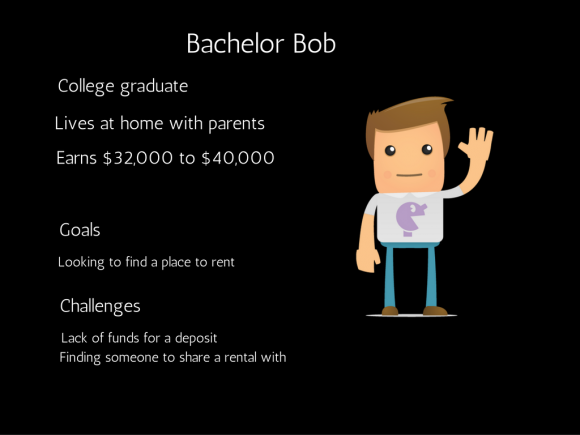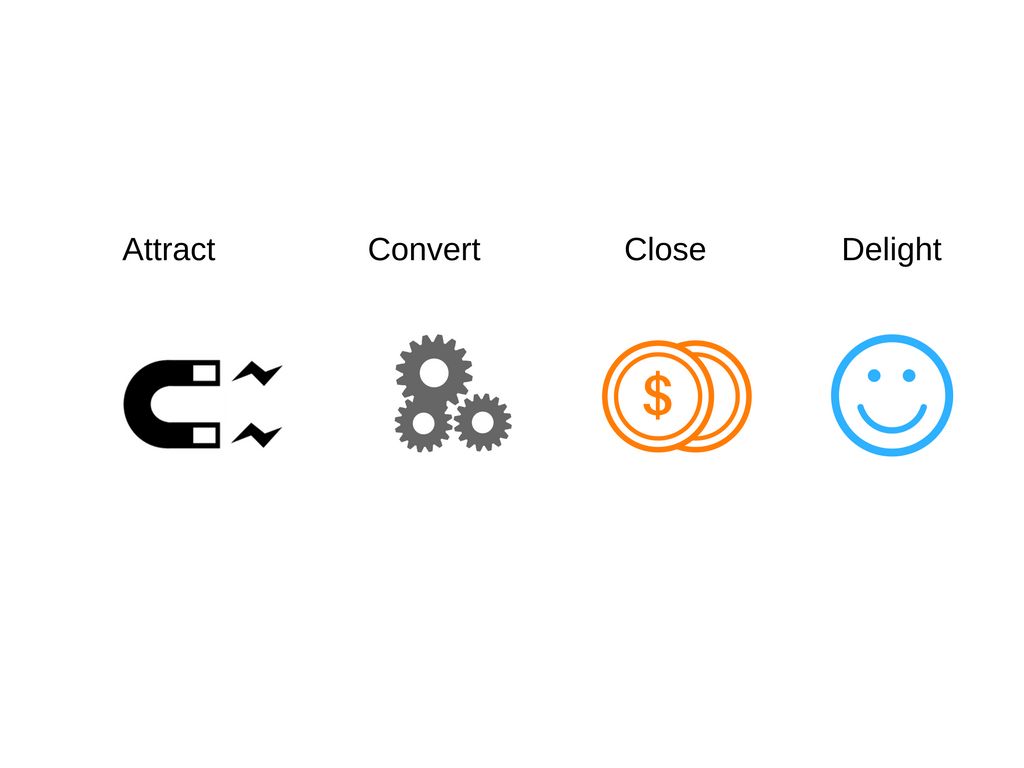If you are looking to sell any kind of product or service online then the old methods of buying display ads and selling to who you think your audience is fast becoming irrelevant. To capture the attention of an audience and turn them from strangers into leads and then customers you need to focus on creating quality content and make them come to you.
How can this be done though? There are 4 main segments to the inbound methodology, attract, convert, close and delight. Let’s look at each of them in detail.
Attract
The first step is that you need to capture the attention of your chosen audience. But who is the audience? Right now they are strangers but we want to make them into visitors. To find out who your target audience is you need to create buyer personas.
A buyer persona is a representation of who your customer might be, what is their age and sex, what are their problems and how are they looking to overcome them? What motivates them, what are their goals and also what activities do they partake in? To get an in-depth understanding of your buyer personas you should make them as detailed as possible and also try to understand what their buyer’s journey is too.

Once you have created your buyer personas you should have an idea of the type of content they consume and where they get this content and you can begin to plan your content creation around this. For example if your target audience are people in the over 50’s or ‘boomers’ demographic are then chances are they aren’t going to be on Snapchat much but they could be on other social platforms such as Facebook and Pinterest and there will be an even higher chance that they read blogs and other web based content.
Now you can create your content and publish it to the places that your buyer persona is most likely to see and consume it. Although there are many different ways to create content to attract your target audience the main 3 are SEO & organic search, blogging and social media.
SEO & organic search – Here you can create content to place on your website that you want to rank for specific search terms that your audience are searching for, this content might be a pdf file or ebook, an infographic, an article or a cheat sheet. The page that the content is placed on needs to be optimized for the target search terms and you may want to also link to it internally using the sam anchor text and if possible build external links too.
Blogging – Blogging is by far one of the best and cost effective ways to produce content to attract your audience and potential new customers. Every blog post page on your website can be optimized for specific search terms so that it rings in organic search traffic and you can share your posts across all your social channels. Finally, you don’t have to only post on your own blog, guest blogging is a great way for not only exposing your brand and message to new readers elsewhere but it can also build quality, related backlinks that will further boost your rankings in the search engines.
Social media – Lastly, social media platforms such as Facebook, Twitter, Pinterest and others are another viable source of attract your desired audience. Remember though, you need to first find out which platform your buyer personas are mainly on, you also need to put the right content across and at the right times. Blasting out endless Tweets on Twitter about your latest sales promotion is just going to annoy people and they may ignore or even unfollow you. Publishing your content at the correct times is also crucial, generally speaking, first thing in the morning, noon and early evening are the peak activity times for social media users.
Should We Give In To Clickbait When Creating Content?
Convert
Once you have attracted people to visit your website you need to convert them into leads, this has to be done by getting them to give up their personal details, something that often isn’t easy to do! Many companies fail at this point and never really manage to get those all important contact details. This is often because they don’t have the right content to capture that lead or they give away too much information in their content and thus the visitor has no need to seek further help from the company and the leave the website.
So what are some of the most effective ways to turn a visitor into a lead? Let’s look at two:
Call to action – A call to action (or CTA) is where you request the user to perform some action such as download a file or click a link. For the latter this will most likely lead the visitor to a landing page.
Landing pages with forms – A landing page should not be like the other pages on your website, it needs to be totally free of clutter so no ads or links or anything else that might distract the visitor. The page should have a clear & concise action-oriented headline as well as clearly stating what it is offering as well as giving a sample or glimpse of what else the viewer can get from the company. The goal of any landing page is to get the visitor to fill out that form so that their contact details, making forms that are simple to understand and concise is important and you need to get the right balance of the visitor being able to complete the form quickly while also getting the right information from them so that they may be nurtured into a lead and customer.
Check out these 25 awesome landing page ideas for inspiration.
Stop Letting Visitors Slip Through Your Fingers By Implementing These Conversion Tips
Close
The close stage is critical, this is the part where you make the sale and that’s what we’ve been working towards right?
In the close stage we are looking to turn your website visitors who are now leads into customers, however, getting people to part with their money is a lot harder than getting them to fill in a form or download a file! Everytime a lead is reading a piece of your content, visiting a page on your website, reading an email from you or interacting with you this is called a ‘touch point’ and marketing data has shown that often as many as 7 to 13 touch points may be needed before a lead closes and makes a purchase.
Email marketing is a highly effective way of enabling multiple touch points with a nurtured lead while at the same time being able to provide them with further content and information on what you do and taking them further down the sales funnel. Even though a visitor may have signed up to receive emails, further analysis is required to ensure that you send them the right kind of email, and at the right time. Segmenting your email subscriber’s list into different sections based on data you have gathered such as how often or when they open your emails and do they click the links within them will help you determine what to send these leads next.
At this point it’s important to know where the lead is at in the buyer’s journey. If they are in the awareness stage then it would be best to send them blog content and free tools, if they are at the consideration stage then webinars and case studies and if they are at the decision stage and ready to make a purchase then demos, consultations and quotes.

Delight
The final part of the inbound methodology is to delight your customers so that they come back again and again. Many companies neglect this part which is one of the worst things you can do, now is the time to go above and beyond your customers expectations. The goal here is to not just make these people into repeat customers but into promoters. There are 3 ways this can be done, innovation, communication and education and they are seen as the ‘pillars’ of the delight stage.
Innovation – Don’t maintain the status quo, always be looking to push the boundaries of what you do and offer, you should always be looking to improve the customer experience so change is absolutely necessary.
Communication – Keep in communication with your customers, address them by their name and don’t make them feel like they are just a number, make them feel special.
Education – Knowledge is power and education empowers, if you educate your customers on the right product and services and how to use them then they can make informed decisions for future purchases.
So that’s the 4 main principles of the inbound marketing methodology. We have only touched on some of the main points and methods and
8 Tools Web Marketers Need In Their Toolbelt in 2016


Hey David,
Static method for growth of blog is also effective by writing more and more blog post and after that sharing on social media.
Be online and helpful to audience and suitable answer for their question, makes our blog dynamic growth. Eventually, thanks for sharing your amazing thought regarding this subject.
With best wishes,
Amar kumar